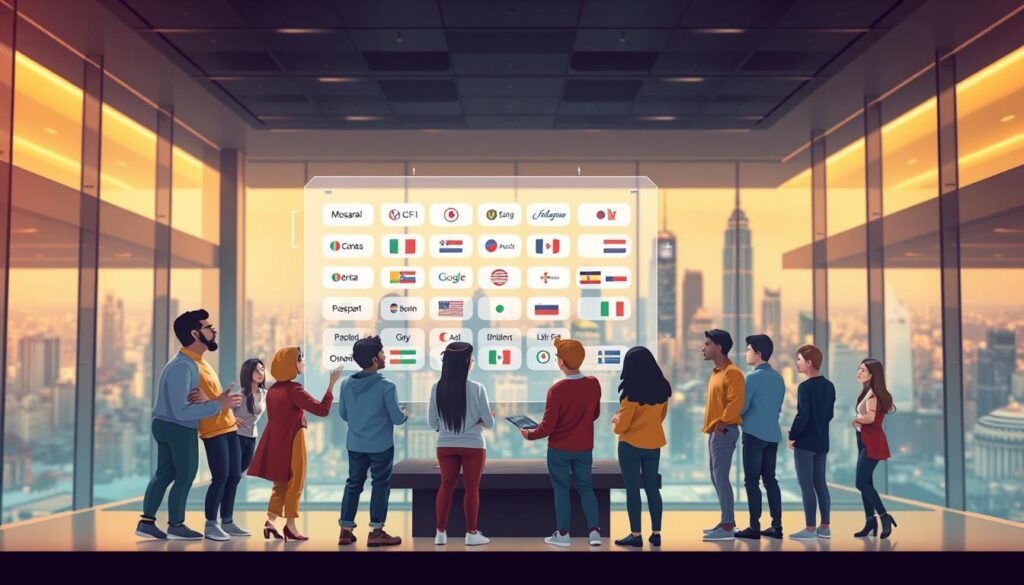In today’s interconnected world, businesses are continually seeking to expand their global reach and connect with diverse audiences.
A study by Common Sense Advisory found that 72.1% of users spend most of their time on websites in their native language, and 72.4% are more likely to buy a product when the information is in their first language.
Effective content creation goes beyond simple translation—it requires cultural sensitivity, localisation, and strategic adaptation to truly engage international audiences.
Key Takeaways
- Multilingual content is crucial for businesses aiming to expand globally.
- 72.1% of users prefer websites in their native language.
- Cultural sensitivity is key to effective multilingual content.
- Language barriers can be transformed into bridges to connect with global audiences.
- Professional multilingual content writing services are in high demand.
The Growing Importance of Multilingual Content in Today’s Global Market
In today’s interconnected world, the significance of multilingual content cannot be overstated. As businesses expand their global footprint, the need to communicate effectively with diverse audiences becomes paramount.
Why Language Matters in Global Business Communication
Language plays a crucial role in global business communication, serving as a bridge between companies and their target audiences. Effective communication in the customer’s native language fosters trust, enhances user experience, and ultimately drives business success. Research has shown that consumers are more likely to engage with brands that provide content in their native language, highlighting the importance of language in building strong customer relationships.
Key Statistics on Consumer Preferences for Native Language Content
Studies have consistently demonstrated that consumers prefer content in their native language. A study by Common Sense Advisory found that 72.1% of users spend most of their time on websites in their native language, and 72.4% are more likely to buy a product when the information is in their first language. The following table summarises key statistics on consumer preferences for native language content:
| Statistic | Percentage |
|---|---|
| Users spending most time on websites in native language | 72.1% |
| Users more likely to buy in native language | 72.4% |
| Consumers preferring native language content | 80% |
These statistics underscore the importance of developing a content strategy that caters to diverse linguistic preferences, thereby enhancing search engine visibility and driving business growth.

Understanding Multilingual Content Writing Beyond Translation
The art of multilingual content writing is not just about translating words, but about conveying the right message to the right audience in the right cultural context.

Companies seeking to expand their brand understand that more and more consumers actively engage with content that appears personalized to them.
The Difference Between Translation, Localisation, and Transcreation
While translation focuses on converting text from one language to another, multilingual content writing encompasses a broader scope, including localisation and transcreation.
Localisation involves adapting content to suit the cultural, linguistic, and regional preferences of a target market, ensuring that the message resonates with local audiences.
Transcreation, on the other hand, involves creatively recreating content to evoke the same emotional response in the target audience as the original content did in its native audience.
Cultural Sensitivity and Its Impact on Content Effectiveness
Cultural sensitivity forms the cornerstone of effective multilingual content, determining whether your message resonates or alienates international audiences.
- Cultural missteps in content can lead to serious consequences, from mild confusion to significant brand damage and lost market opportunities.
- Effective cultural adaptation considers visual elements, colour choices, imagery, and examples that resonate with local audiences, setting the right tone for engagement.
- Brands that demonstrate cultural intelligence through their content create stronger emotional connections with international audiences, leading to improved engagement and loyalty.
Benefits of Investing in Professional Multilingual Content Services
As global markets continue to evolve, businesses are recognising the value of multilingual content in connecting with customers worldwide. This realisation is driving companies to invest in professional multilingual content services to expand their global reach and improve customer engagement.
Expanding Global Reach and Market Penetration
By adopting multilingual content marketing strategies, businesses can effectively penetrate new markets and reach a broader audience. This approach enables companies to tailor their content marketing efforts to specific regions, enhancing their global presence.
| Benefits | Description | Impact |
|---|---|---|
| Market Expansion | Entering new markets with tailored content | Increased global presence |
| Customer Engagement | Connecting with customers in their native language | Improved brand loyalty |
| Competitive Advantage | Standing out in a crowded global market | Enhanced market share |
Building Trust and Enhancing User Experience
Providing content in a customer’s native language fosters trust and significantly enhances user experience. When product information, testimonials, and support content are localised, it removes barriers to purchase and streamlines the customer journey.
Improving Conversion Rates and ROI
The investment in professional multilingual content typically delivers strong ROI through increased international sales, improved customer retention, and expanded market share. By enabling more effective targeting and personalisation, multilingual content marketing improves marketing efficiency and reduces cost per acquisition.
By leveraging multilingual content, businesses can drive higher conversion rates, enhance engagement, and strengthen their brand presence globally.
Developing a Comprehensive Multilingual Content Strategy
A comprehensive multilingual content strategy is the backbone of any successful global marketing effort, enabling businesses to communicate effectively across linguistic and cultural boundaries.

Identifying Target Markets and Languages
Identifying the right target markets and languages is a critical first step in developing a multilingual content strategy. This involves conducting market research to understand the linguistic and cultural nuances of the target audience. By doing so, businesses can tailor their content to resonate with their new audience, thereby increasing engagement and conversion rates.
Creating a Multilingual Content Calendar
A multilingual content calendar is essential for organising and scheduling content across different languages and regions. It helps in maintaining a consistent content publication schedule, ensuring that all markets receive relevant and timely content. This tool is vital for coordinating efforts across teams and ensuring that the content is culturally appropriate and sensitive to local sensibilities.
Maintaining Brand Consistency Across Languages
Maintaining brand consistency across languages is crucial for building a strong global brand identity. This involves developing comprehensive brand guidelines that define core elements such as tone, voice, logos, and typography, while allowing for cultural adaptation. Key strategies include creating style guides for each language, managing terminology through multilingual glossaries, and conducting regular brand alignment reviews. Additionally, training content creators and translators on brand values and voice is essential, as is leveraging technology solutions like translation memory and brand asset management systems to streamline the content creation process.
By implementing these strategies, businesses can ensure that their brand message is conveyed consistently across different languages and cultures, thereby enhancing their global reach and credibility.
The Multilingual Content Writing Process: A Step-by-Step Approach
Multilingual content writing is a nuanced process that necessitates careful planning and execution. To effectively reach global audiences, businesses must consider various factors, including cultural nuances, language preferences, and regional sensitivities.

Research and Planning for Multiple Markets
The first step in creating successful multilingual content is thorough research and planning. This involves identifying target markets, understanding local consumer behaviour, and analysing competitors. By doing so, businesses can tailor their content to meet the specific needs of each market, thereby increasing its effectiveness.
Content Creation and Adaptation Workflows
Once the research and planning phase is complete, the next step is content creation and adaptation. This involves developing high-quality content that resonates with the target audience. Experienced writers and localisation experts work together to ensure that the content is not only translated accurately but also adapted to fit the cultural context of each market. This process requires careful attention to detail and a deep understanding of the target audience.
Quality Assurance and Cultural Review
To ensure that the multilingual content meets the highest standards, a rigorous quality assurance process is implemented. This includes multiple rounds of editing and review to check for accuracy, cultural sensitivity, and brand consistency. As noted by industry experts, having two rounds of editing is crucial, with the first edit focusing on accuracy and adherence to the brief, and the second edit concentrating on tone, grammar, and style. This meticulous process helps prevent costly mistakes and ensures that the content is effective in engaging the target audience over time.
Some key aspects of quality assurance include:
- Rigorous quality assurance processes ensure multilingual content maintains accuracy and cultural appropriateness.
- Native-speaking reviewers provide crucial cultural context that automated tools might miss.
- Standardised quality metrics help maintain consistent standards across languages.
- Cultural review processes identify potential sensitivities before publication.
By following this step-by-step approach, businesses can create effective multilingual content that resonates with their global audience, ultimately driving success in their target markets. This comprehensive process is essential for any business looking to expand its global reach through a blog post or other forms of content.
Essential Tools and Resources for Multilingual Content Creation
In today’s global market, having the right tools for multilingual content creation is crucial for success. Businesses looking to expand their global reach must invest in the appropriate resources to streamline their content creation process.

Content Management Systems with Multilingual Capabilities
A robust Content Management System (CMS) is the backbone of any successful content strategy. Modern CMS options like WordPress, Drupal, and Adobe Experience Manager offer multilingual capabilities, enabling businesses to manage their content across different languages efficiently. These platforms provide features such as language support, translation workflows, and localisation options, making it easier for writers to create and manage multilingual content.
Translation and Localisation Tools
Effective translation and localisation are critical components of multilingual content creation. Tools like Smartcat, MemoQ, and SDL Trados facilitate the translation process, ensuring accuracy and consistency across languages. These tools also help manage the workflow, time-saving, and reducing the complexity associated with translating content.
Collaboration Platforms for International Teams
Collaboration is key to successful multilingual content creation, especially for teams spread across different geographies. Platforms like Slack, Trello, and Asana enable teams to work together seamlessly, regardless of their location or language. These platforms offer features like real-time communication, task management, and document sharing, ensuring that all team members are on the same page.
Overcoming Common Challenges in Multilingual Content Writing
The complexities of multilingual content writing require careful consideration of cultural, linguistic, and SEO factors. As companies expand their global footprint, they must navigate the intricacies of creating content that resonates with diverse audiences while maintaining their brand identity.
Managing Cultural Nuances and Sensitivities
Cultural sensitivity is paramount in multilingual content writing. Transcreation plays a crucial role in this process, allowing brands to adapt their messaging to resonate with local audiences while maintaining the core emotional impact of their campaigns. This is particularly important for taglines, slogans, and social media content.
To effectively manage cultural nuances, brands must develop a deep understanding of local cultures and preferences. This involves more than just translation; it requires a nuanced approach that considers the cultural context of the target market.
Addressing SEO Considerations Across Languages
SEO considerations are another critical aspect of multilingual content writing. Different languages and regions have unique search engine optimisation requirements. For instance, a keyword that is effective in one market may not be relevant in another. Therefore, it’s essential to conduct thorough keyword research for each target market.
Maintaining Consistency While Adapting to Local Markets
Balancing global brand consistency with local market relevance is a significant challenge. To achieve this balance, brands should develop clear guidelines that distinguish between non-negotiable elements and flexible aspects that can be adapted locally.
| Strategy | Description | Benefits |
|---|---|---|
| Content Governance Frameworks | Establish clear approval processes for market-specific adaptations | Maintains brand consistency while allowing local flexibility |
| Centralised Asset Management | Ensures core brand elements remain consistent across markets | Enhances brand recognition globally |
| Training Programmes for Local Teams | Educates local teams on global brand principles and local application | Improves local market relevance while maintaining brand integrity |
By implementing these strategies, businesses can effectively overcome the common challenges associated with multilingual content writing, ensuring their content resonates with global audiences while maintaining a consistent brand identity.
Conclusion: Embracing Multilingual Content as a Competitive Advantage
The journey to global success is paved with the ability to communicate effectively across languages, making multilingual content creation a vital component of any international content marketing strategy. By embracing multilingual content, businesses can expand their market reach, foster stronger customer relationships, and enhance their brand perception worldwide.
Forward-thinking organisations understand that multilingual content marketing is not just a tactical decision but a strategic approach to global business that creates a sustainable competitive advantage. As global connectivity continues to increase, brands that communicate authentically across languages will build the trust and loyalty necessary for long-term success.
Investing in quality multilingual content delivers returns through expanded market opportunities, improved customer engagement, and enhanced brand reputation. By prioritising content creation in multiple languages, organisations demonstrate their commitment to truly global engagement and customer-centricity, positioning themselves for success in an increasingly interconnected world.






